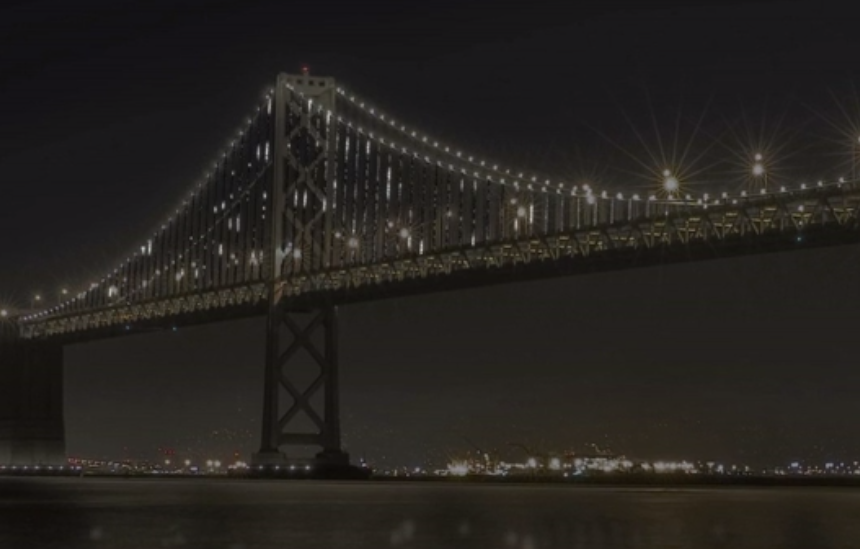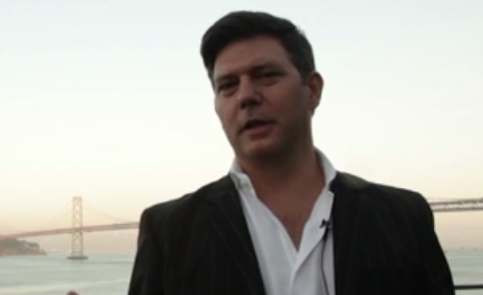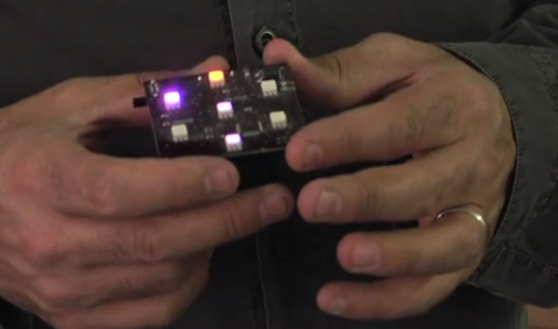 SAN FRANCISCO — The world’s largest LED light sculpture will light up San Francisco tonight: 1.8 miles long, 500 feet high, and consisting of 25,000 individually programmed lights tied to the entire length of the Bay Bridge’s western span, the Bay Lights Project represents a massive melding of technology, art, and city.
SAN FRANCISCO — The world’s largest LED light sculpture will light up San Francisco tonight: 1.8 miles long, 500 feet high, and consisting of 25,000 individually programmed lights tied to the entire length of the Bay Bridge’s western span, the Bay Lights Project represents a massive melding of technology, art, and city.
At 8:30 tonight during the Grand Lighting, the Bay Lights will begin its tenure as a local icon, shining all night, every night for two years.
Swapping canvas for computers
Leo Villareal is the man behind the sculpture. He has built installations around the world, such as the National Gallery of Art in Washington, D.C., or a skyscraper in Seoul Korea. The Bay Bridge Project is his biggest and most public undertaking yet. Like the Wizard of Oz, he creates a scene of drama and awe from behind a curtain, or in this case, a computer.
“We are adding a grid of lights to the suspension cables of the bridge. 25,000 white LED nodes spaced every foot,” Villareal said in a video about the project. “Each node will be individually addressable. This is a very unique way to light a bridge. Each single pixel is controllable but working as a group to create an overall effect.”
Villareal writes software that conducts the lights. The algorithms in the code create visualized patterns, which he ‘[- -0curates based on artistic inclination. Sometimes, the lights will follow completely random patterns, whereas other times, they could resemble the breeze over the bay or flying birds.
“We live in a moment now when artists born 20 or 30 years [ago] grew up with tools that weren’t just oil or wash but code and hardware,” said Peter Hirshberg, the cofounder of the Gray Area Foundation for the Arts. “Artists are now expressing themselves with technology in a way that is artful, soulful, and expressive. The Bay Lights Project is not only a monumental piece of art but [also] a unique form of culture. We have a shot of doing something as culturally important as what went on with jazz and Broadway from the 1920s on.”
‘Paris, eat your heart out’
Scale is a key factor in this endeavor, which includes 100,000-plus feet of bridge cables, 48,000 bridge clips, $11,000 in energy costs, and $8 million in financial support. The project’s organizers predict that it will reach over 50 million people in the Bay Area and bring in $97 million to the local economy.
On paper, the installation is temporary, which allowed the artist, partner organizations and municipal bodies to get around some of the bureaucracy that could have blocked its fulfillment if it had been presented as a permanent installation.
But it may wind up being somewhat more permanent.
“Paris, eat your heart out,” said California Lieutenant Gov. Gavin Newsom (a former San Francisco mayor) at the project’s official announcement in September. “You’ve got the Eiffel Tower; we’ve got the Bay Bridge. Forget permanent art — the key is temporary art. You can bypass whole processes, and once you put it in, you never have to take it out.”
Local officials may have learned a little something from the startup community with this approach. Rather than relying on existing channels and precedent, the project’s supporters created a prototype, built a minimal viable project, took “angel money,” and set off to “disrupt” the the local environment as well as the international art scene.
The Bay Lights Project was first conceived by Ben Davis, founder of non-profit Illuminate the Arts. He was sitting at the Ferry Building starting at the bridge and thinking of ways to bring the infrastructure to life.
“I was inspired by the nightscape of the playa at Burning Man and frustrated that all that beautiful energy dissipated into the night sky,” Davis said. “I wanted to find a way to bring that energy, generosity, spectacle, and awe back to that place that we live and let it stay longer. This is not just a bridge now, it is a canvas for light and a digital campfire that will have a personal impact on each and every of the 50 million people that see it.”


